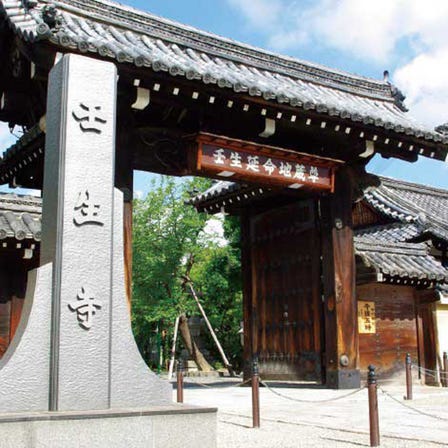Description
Not far south of Kyoto Station is To-ji Temple, the prominent five-story pagoda you can see from the window of the Shinkansen. To-ji Temple was built in 796 to accompany the construction of Heian-kyo. Its position is just east of the Rajo-mon gate, which is regarded as the south entrance to Kyoto, to protect the Imperial Palace. Emperor Saga gave the temple to Kobo Daishi Kukai in 823 and it became the central training center of Shingon Esoteric Buddhism. Although many of the main temple buildings were burned down due to Doikki (peasant uprising) in 1486, the Toyotomi and Tokugawa families provided support to rebuild it over time. The iconic five-story pagoda that symbolizes To-ji Temple, was rebuilt and dedicated by the third Tokugawa Shogun, Iemitsu in 1644. The arrangements and scales of reconstructed buildings such as the Nandai-mon gate, Kon-do Hall, Lecture Hall, and Dining Hall are exactly as they were in the Heian period. In 1994, the temple was added to UNESCO's List of World Cultural Heritage sites as one of the Historic Monuments of Ancient Kyoto.
Three-dimensional Mandala that visually depicts the teachings of Esoteric Buddhism
On the Shumi-dan (an altar for placing a principal image in Buddhist temples) in the Lecture Hall at the center of To-ji Temple, you will see 21 Buddhist statues arranged to visually represent Katsuma Mandala, generally known as a three-dimensional Mandala. Seated at the center is the principal Buddha, Dainichinyorai. The 21 statues include Nyorai (a person who has attained Buddhahood), Bosatsu (a Buddhist saint), Myo-o (the deity of fire), and Tenbu (the guardian of Buddhism who protects Nyorai and Bosatsu), made by Kobo Daishi Kukai, convey the teachings of Kukai to the present generation.
Kon-do Hall, the main hall rebuilt with contributions from Hideyori Toyotomi
The Kon-do Hall is To-ji Temple's main hall. Construction of the hall began shortly after the temple's founding and it survived until Doikki (peasant uprising) of 1486. It was rebuilt thanks to contributions from Hideyori Toyotomi in 1603. In addition to the seated statue of Yakushi Nyorai, which is the principal image of the temple, Nikko Bosatsu and Gakko Bosatsu are enshrined there. These statues have been designated as an Important Cultural Property together with Yakushi Sanzonzo (triad image of Yakushi Buddha).
The five-story pagoda, Japan's tallest wooden structure and the symbol of Kyoto
The five-story pagoda you can spot when looking south from the window of your Shinkansen is Japan's tallest wooden structure. Soaring 55 meters into the sky, it is Kyoto's primary landmark. The present pagoda is actually the fifth incarnation built in 1644 with contributions from Iemitsu Tokugawa; its four predecessors all succumbed to fire. According to tradition, it houses Busshari (the ashes of Buddha's bones) brought by Kobo Daishi Kukai from Tang (China). The first layer of the pagoda, which is usually not open to the public, contains the enshrined four statues of Nyorai that surround the central pillar, which represents Dainichinyorai, and eight statues of Bosatsu.
Location Information
-
- Address
-
1, Kujocho, Minami-ku, Kyoto-shi, Kyoto, 601-8473
-
- Nearest Station
-
Toji Station
・ Kintetsu-kyoto Line
10 minutes on foot
-
- Phone Number
-
075-691-3325Available languagesonly in Japanese
-
- Hours
-
5:00am - 5:00pm
*Open
8:00am - 5:00pm
*Kondo (Main Hall) and Kodo (Lecture Hall) viewing
-
- Closed
- None
-
- Public Site
- Official Site
Recommended Spots in Area
- Visiting
- Eating
- Shopping
- Lodgings
-
 Tofuku-ji TempleKyoto Station, To-ji TempleTemples
Tofuku-ji TempleKyoto Station, To-ji TempleTemples -
 Bukkoji TempleGion, Kawaramachi, Kiyomizu-dera TempleTemples
Bukkoji TempleGion, Kawaramachi, Kiyomizu-dera TempleTemples -
 Kyoto National MuseumKyoto Station, To-ji TempleHistory Museums
Kyoto National MuseumKyoto Station, To-ji TempleHistory Museums -
 Houkou-ji TempleKyoto Station, To-ji TempleTemples
Houkou-ji TempleKyoto Station, To-ji TempleTemples -
 Mibu-dera TempleGion, Kawaramachi, Kiyomizu-dera TempleTemples
Mibu-dera TempleGion, Kawaramachi, Kiyomizu-dera TempleTemples -
 Shosei-en Garden (Kikokutei)Kyoto Station, To-ji TempleGardens
Shosei-en Garden (Kikokutei)Kyoto Station, To-ji TempleGardens
-
Wagyu Sukiyaki Kyotogotengo KarasumaGion, Kawaramachi, Kiyomizu-dera TempleSukiyaki
-
Otachidokoro SushikiGion, Kawaramachi, Kiyomizu-dera TempleSushi
-
Shichijo Kanshundo ShazakissaKyoto Station, To-ji TempleOther Cafes and Sweets
-
Sushi Tamahime KYOTOKyoto Station, To-ji TempleJapanese cuisine
-
GiontamejiroHachijoguchiKyoto Station, To-ji TempleSet Meal (Gozen)
-
Man in the MoonKarasumaGion, Kawaramachi, Kiyomizu-dera TempleOther Restaurants
-
EDION Corporation AEON Kyoto Rakunan StoreKyoto Station, To-ji TempleElectronics Stores
-
Hands (Kyoto)Gion, Kawaramachi, Kiyomizu-dera TempleHousehold Goods Stores
-
Kyoto Station BuildingKyoto Station, To-ji TempleShopping Malls
-
BUYSELL Kyoto Shijo-dori storeGion, Kawaramachi, Kiyomizu-dera TempleClothing Stores
-
Joshin OUTLET Kujou Karasuma StoreKyoto Station, To-ji TempleElectronics Stores
-
Aeon Mall KyotoKyoto Station, To-ji TempleShopping Malls
-
Yugen Kyoto ShijoKyoto Station, To-ji TempleHotels
-
Kyoto Century HotelKyoto Station, To-ji TempleHotels
-
The Thousand KyotoKyoto Station, To-ji TempleHotels
-
MarufukuroKyoto Station, To-ji TempleHotels
-
Hotel Bell KyotoKyoto Station, To-ji TempleHotels
-
Six Senses KyotoKyoto Station, To-ji TempleHotels













































